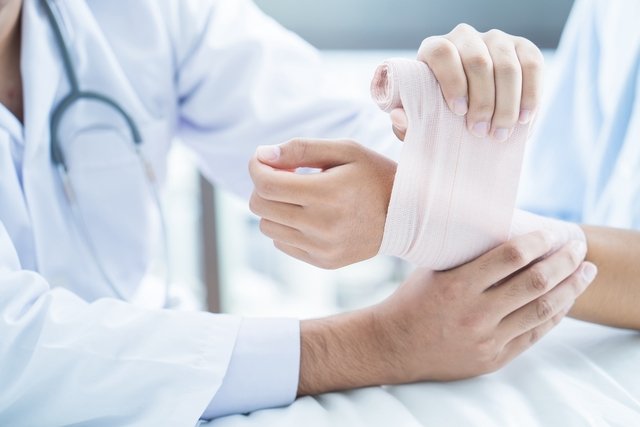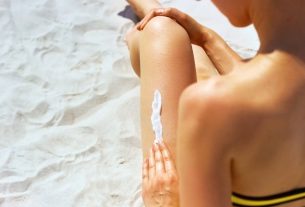To heal a wound quickly, it is important to take certain precautions, such as washing the wound and dressing it, eating a healthy diet and using ointments and healing products.
Furthermore, it is advised to avoid lifestyle habits that can interfere with skin healing, such as smoking, drinking alcoholic beverages or having a sedentary lifestyle. These habits tend to impair blood circulation, causing less blood to reach the wound, thus delaying the healing process.
Wounds that are deep, very extensive or show signs of infection, such as pus, swelling or pain, should always be evaluated by a doctor or nurse, as they may require more appropriate treatment.

Some steps that guarantee faster healing and prevent the appearance of ugly scars and other complications are:
1. Wash dry
For simple wounds, such as a cut or scrape, the first step should be to wash the wound and the surrounding skin to remove as much bacteria and viruses as possible, preventing the development of an infection. This washing can be done with saline solution, but also with water and neutral pH soap.
In surgical wounds or those that are more serious and exposed, although washing is also recommended, it must generally be done with saline solution and sterilized material and, therefore, it is very important to go to the hospital. However, if the wound is very dirty, you can apply some saline solution to remove the dirt before going to the hospital.
2. Apply a bandage
After washing the wound, in the case of simple wounds, a dressing should be applied, at least for the first 24 hours, while the scab has not yet formed, in order to avoid reopening the wound and the entry of bacteria into the wound. In addition, it is recommended to change the dressing daily while the wound heals, or as directed by your doctor or nurse. See how to make a bandage correctly.
In the case of larger, uninfected wounds, 2nd degree burns, dry or moderately moist wounds, or decubitus wounds, bedsores or leg ulcers, the doctor may recommend a hydrogel dressing, which allows gas exchange, and is impermeable to liquids. or bacteria, and accelerates skin healing.
Changing this dressing must be done according to the brand of hydrogel dressing or as recommended by a doctor. Learn how to use the hydrogel correctly.
3. Cool the skin
Cooling the skin is the first recommended measure in the case of 1st and 2nd degree burns, and the affected area must be placed under cold running water for at least 15 minutes, to prevent the heat from continuing to burn the skin internally and cause wounds. serious. Then, the area should be washed with water and neutral soap, and a bandage may be applied as instructed by the doctor or nurse.
Furthermore, it is important in these cases not to burst the blister that has formed on the skin, as they help to protect the skin while the wound heals. It is also important not to apply any product that has not been recommended by your doctor.
These measures help the skin and wound heal faster. See other measures to help the burn healing process.
4. Apply heat to the wound for 15 minutes
Applying a warm compress to the bandage or wound for 15 minutes helps increase blood flow to the region, increasing the amount of nutrients and cells in the area, accelerating healing. This technique can be done between 2 and 3 times a day, but should only be done after the scab has formed.
If the area becomes very swollen or causes pain, you should remove the compress and avoid applying heat during that day or, apply the compress for less time.
Applying heat to the wound should not be done in cases of skin burns.
5. Keep the wound elevated
When the wound site is swollen for more than 2 days, it is important to try to elevate the wound to reduce fluid accumulation and facilitate blood circulation. This type of swelling is more common in people who have heart or circulation problems and usually appears in wounds on the legs.
Therefore, it is important to place your legs about 20 cm above heart level at least 3 times a day or whenever possible.
6. Consume omega 3 and vitamins A, C and E
Foods rich in omega 3, such as salmon, tuna or chia seeds, as well as those rich in vitamin A, C and E, such as oranges, mangoes, tomatoes or peanuts, are a great way to strengthen the organism and stimulate the formation of tissue that closes the wounds and helps in the creation of the new layer of skin.
Therefore, eating a diet richer in this type of food and avoiding others that hinder healing, such as sugar, soft drinks, chocolate milk or fatty pork, for example, is an excellent way to ensure faster healing. of the wound. Check out a more complete list of healing foods and those you shouldn’t eat.
Remedies to heal wounds
Wound healing remedies are mainly ointments for topical use, which contain substances with anti-inflammatory or antimicrobial action, helping skin cells to recover more quickly or preventing the proliferation of microorganisms that can cause infections.
Furthermore, these ointments provide important nutrients for the regeneration of the new layer of skin, in addition to being able to reduce inflammation that hinders healing, and can be recommended for post-surgical wounds, cesarean sections, burns or skin wounds caused by trauma or bumps, for example.
However, they should only be used approximately 3 to 5 days after the wound appears and with the guidance of a doctor or nurse, as some ointments may contain antibiotics, without them being necessary to treat the wound. See the list of the best healing ointments.
Medicine to heal deep wounds
Remedies for healing deep wounds, such as bedsores, decubitus ulcers, venous or arterial ulcers, are Dersani oil, or ointments, such as fibrinolysin or collagenase, for example, as they help to heal the wound more quickly, remove dead skin cells and promote deep cleansing of the skin, and should only be used if recommended by a doctor. See the main treatments for bedsores and wound care.
Generally, these remedies for healing deep wounds are used in health centers or hospitals, applied by the nurse, after cleaning and debridement of the wound by the doctor, to remove necrotic, dead, and infected tissue from the wounds, allowing better healing. .
In addition, the doctor may also recommend the use of antibiotic ointments, such as silver sulfadiazine, if the wound is infected.
How healing happens
Healing is a repair process that can be divided into 3 main phases:
- Inflammatory phase: lasts between 1 and 4 days and begins with a constriction of the blood vessels, to prevent bleeding. But then, this phase evolves into the dilation of the vessels, so that blood reaches the site with all the cells necessary for healing, generating symptoms such as swelling, redness and pain;
- Proliferative phase: lasts between 5 and 20 days and, in this phase, the formation of collagen and other fibers begins that help close the wound;
- Maturation phase: is the longest phase that can last between 1 month and several years, in which the body continues to produce collagen and correct the balance of wounds in the scar, which allows it to decrease over time.
When any of these phases does not occur, whether due to a lack of blood in the region or an infection, healing is compromised and a chronic wound may arise, as happens in the case of diabetic foot, in which the wound needs to be treated by a nurse for several months or even years.
Warning signs to go to the doctor
Although most wounds heal without any complications, there is always the chance of an infection at the site, for example. Therefore, it is important to go to the hospital if signs such as:
- Intense swelling that does not improve after 3 days;
- Presence of pus in the wound;
- Excessive bleeding;
- Very intense pain;
- Difficulty moving the affected limb.
Furthermore, other symptoms such as persistent fever or excessive tiredness may also indicate that the wound is infected and, therefore, should also be evaluated.

Sign up for our newsletter and stay up to date with exclusive news
that can transform your routine!
Warning: Undefined array key "title" in /home/storelat/public_html/wp-content/plugins/link-whisper-premium/templates/frontend/related-posts.php on line 12
Warning: Undefined array key "title_tag" in /home/storelat/public_html/wp-content/plugins/link-whisper-premium/templates/frontend/related-posts.php on line 13



